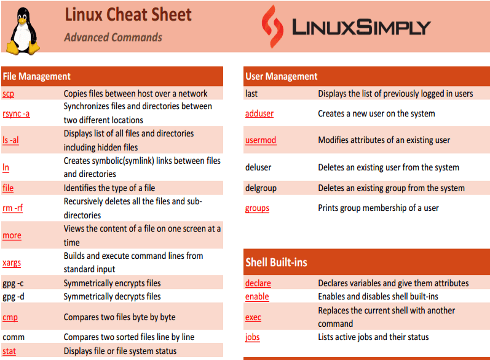A Linux command is a particular instruction that is written in the Linux terminal to execute specific tasks. Commands can be used for navigating files and directories, changing permissions, installing packages and configuring applications, and so on. Advanced Linux commands are somewhat more powerful than basic commands. A few keystrokes of an advanced command can perform tasks in seconds that may take hours while using GUI.
In this article, I will give you a cheat sheet for the Advanced Linux Commands with free downloadable links.
Download Advanced Linux Commands Cheat Sheet
Advanced Linux Commands Cheat Sheet
Advanced Linux commands can be categorized into various types such as File Manipulation, Network Commands Hardware Based Commands, etc. Available advanced Linux commands are:
Advanced Linux Commands for File Management
Here is a short list of advanced Linux file management commands:
Here is the list of commands for adding new user, modifying existing user, permissoin management and other advanced task related to user management: Linux system commands are used in a wide range of functions. They are: Shell built-in commands are not executable like the system commands. However, these commands are useful for performing similar tasks. To control, monitor and manipulate processes of a Linux system, the below advanced process related commands are available in Linux: Here is a short list of advanced Linux file compression commands: Use the below hardware-based commands on Linux to interact with computer hardware from the terminal window: Here is a short list of advanced Linux networking commands: Here is a short list of advanced Linux disk management commands: Here is a short list of advanced kernel and module related commands in Linux: This section contains many other useful commands regardless of their category. A glance at these may save hours of learning commands from the beginning. In conclusion, the above commands will help a power user to do his job within the quickest amount of time. On the other hand, the list can be useful for learners as well to get hands-on experience with advanced Linux commands. No matter whether the list helps you or not feel free to comment below whatever comes to your mind just after seeing the list. Here are five essential Linux commands that every admin should know: A cheat sheet is a concise set of notes used for quick reference. In the context of Linux, a cheat sheet is a document that contains a list of commonly used commands and their syntax. It is a useful resource for beginners and experienced users alike who want to quickly look up a command or its options. Commands featured in such a cheat sheet might cover various aspects, including but not limited to: Yes, using advanced commands without understanding their impact can lead to unintended consequences, such as data loss, system instability, or security vulnerabilities. It’s crucial to learn about the commands thoroughly and practice in a controlled environment.Command
Description
scp
Copies files between host over a network
rsync -a
Synchronizes files and directories between two different locations
ls -al
Displays list of all files and directories including hidden files
ln
Creates symbolic(symlink) links between files and directories
file
Identifies the type of a file
rm -rf
Recursively deletes all the files and sub-directories
more
Views the content of a file on one screen at a time
xargs
Builds and execute command lines from standard input
gpg -c
Symmetrically encrypts files
gpg -d
Symmetrically decrypts files
cmp
Compares two files byte by byte
comm
Compares two sorted files line by line
stat
Displays file or file system status
split
Splits a file into pieces
cut
Removes sections from each line of a file
paste
Merges lines of files
install
Copies files and set attributes
jed
Simple text editor
vi
Visual text editor
sed
Stream editor for filtering and transforming text
Advanced Linux Commands for User Management
Command
Description
last
Displays the list of previously logged in users
adduser
Creates a new user on the system
usermod
Modifies attributes of an existing user
deluser
Deletes an existing user from the system
delgroup
Deletes an existing group from the system
groups
Prints group membership of a user
Advanced Linux System Commands
Command
Description
chage
Changes user password expiry information
fsck
File system consistency check and repair
sestatus
Shows SELinux status information
iptables
Administration tool for IPv4 packet filtering and NAT
service
Starts, stops and restarts services
Shell Built-in Commands
Command
Description
declare
Declares variables and give them attributes
enable
Enables and disables shell built-ins
exec
Replaces the current shell with another command
jobs
Lists active jobs and their status
Advanced Commands for Process Management
Command
Description
pmap
Reports the memory map of a process
top
Shows real-time dynamic display of the running processes
kill pid
Terminates specific process
pkill
Terminates one or more processes based on attributes
bg
Resumes a suspended job in the background
fg
Brings a background job to the foreground
renice
Changes the priority of a running system
pgrep
Searches for a process by name
pstree
Shows system processes in a hierarchical tree structure
Advanced Commands for File Compression
Command
Description
tar -cf
Creates an archive file and compresses one or more file into it
tar -xf
Extracts files and directories from a tar file
tar -zcvf
Creates an archive tar file and compresses one or more files while showing the progress
gunzip
Decompresses the compressed files
rar
Create, manage RAR archive files
unrar
Extract files from RAR archives
7z
Create, manage and extract files from 7z archives
Advanced Hardware Based Commands
Command
Description
dmesg
Displays bootup messages
Ishw
Lists hardware information of the system
Isblk
Lists information about available block devices
free
Displays information about system’s memory
lspci
Displays list of all PCI bushes and devices
lsusb
Displays information about USB bushes and devices
demidecode
Reports the system’s BIOS information
biosdecode
Displays system’s BIOS firmware information
hdparm -I /dev/sda
Displays information about first hard drive
hwinfo –short
Displays summary of hardware information
wodim
Burns CDs, DVDs and Blu-ray discs
badblocks
Checks damaged or unreadable blocks in storage
x86info -a
Displays general information about CPU
Advanced Commands for Networking
Command
Description
ip addr show
Displays information about network interfaces
ip address add
Adds a new IP address to a network interface
ifconfig
Configures network interfaces with specific IP address
ping host
Tests connectivity to a host
whois
Retrieves information about a domain
dig
Retrieves DNS records of a domain
traceroute
Traces the route of a host
ssh
Secures encrypted communication
netstat -pnltu
Displays information of active TCP and UDP connections
host
Obtains information about a domain name or IP address
hostname -i
Displays IP address of current hostname
telnet
Establishes remote connection
finger
Displays user information
ftp
File Transfer Protocol client
sftp
Secures File Transfer Protocol client
nslookup
Queries Internet name servers interactively
Advanced Commands for Disk Management
Command
Description
df -h
Displays free and used spaces on the file system
df -i
Displays inode usage on the file system
fdisk -l
Lists available disk partition and their sizes
du -sh
Shows total size and of a directory or file
findmnt
Shows list of currently mounted file systems
mount
Mounts a device to specific directory
umount
Unmounts a currently mounted file system
tree
Displays directory structure in a tree format
Advanced Commands for Kernel & Module
Command
Description
uname -a
Display kernel version
ismod
Check currently loaded kernel module
modinfo
Display information of about a kernel module
modprobe –remove
Unload a kernel module from memory
Advanced Miscellaneous Commands
Command
Description
vmstat
Reports virtual memory statistics
alias
Creates a shortcut for a longer command
unalias
Removes previously created alias
ufw
Manages firewall rules
tr
Translate or delete characters from a text stream
tty
Print the file name of the terminal connected to standard input
time
Measure execution time of a command
printenv
Print values of all environment variables
make
Builds executable programs and libraries from source code
whereis
Locate binary, source and manual page of a command
which
Returns the pathname of file
unset
Removes value of an environment variable
tee
Read Standard Input and writes it both to Standard Output and other file
awk
Extracts and manipulates text data
crontab
Instructions for running scheduled job
chroot
Changes the root directory for the current process
timedatectl
Changes system clock and time-zone
at
Schedule commands to run at a specific time
bash
A shell command interpreter
egrep
Search files for lines matching a pattern using extended regular expressions
env
Display and modify environment variables
getend
Print the end of a file
lsof
List open files and their associated processes
mkfs
Create a file system on a device
neofetch
Displays system information in the terminal
uptime
Shows system uptime and load averages
screen
Terminal multiplexer with session management
patch
Apply changes to files using a diff file
batch
Scheduled jobs to run at a later time when system resources are available
strace
Trace system calls and signals of a program and its child processes
curl
Transfer data from or to a server using variety of protocols
rsyslog
Manages system logs and forwarding them to other systems
journalctl
View and manipulate logs from the system journal
source
Read and execute file content in the current shell
let
Assign an integer value to a variable
uniq
Remove or identify duplicate lines of a file
set
List name of all shell variables and functions
Conclusion
People Also Ask
What 5 commands a Linux admin should know?
What is cheat sheet in Linux?
What commands are typically included in an advanced Linux command cheat sheet?
Are there risks in using advanced commands without understanding them fully?
FUNDAMENTALS
A Complete Guide for Beginners

